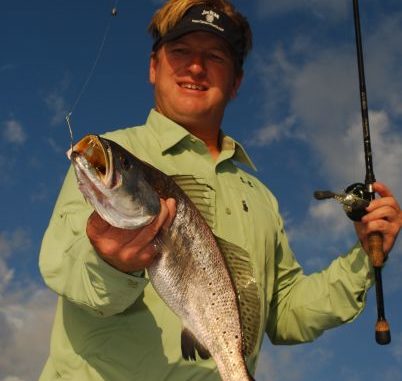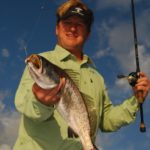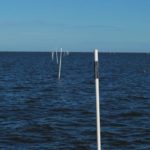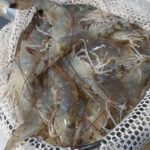
This area of the state has developed the reputation for providing the closest thing that exists to a 12-month-a-year speckled trout fishery.
Most access to the area comes from the fishing communities of Delacroix, Hopedale and Shell Beach.
And both of our experts fairly gushed at the success of the 2013 speckled trout season in their area, but both also expressed reservations about the future.
Kerry Audibert of Ought to Be Fishing Charters (504-259-5304), called his 2013 season amazing.
“The trout showed up early outside — the end of February-early March — and the fishing was fantastic through the summer,” Audibert said. “Everything that was supposed to happen did happen where it was supposed to happen.”
By “outside,” Audibert is referring to the open waters of Black Bay and Breton Sound. His preference is to fish out of sight of land in 12 to 20 feet of water, where he said trout average larger than those in or near grassy marshes.
Charlie Thomason of Capt. Charlie Thomason’s Bayou Charters (504-278-3474) had a slower-starting spring than Audibert, but his season progressed to what he called “absolutely great — the best since Hurricane Katrina” during the summer and through the entire fall.
“Our area,” which Thomason defined as Black Bay to the Ship Channel (MRGO), “was slower than normal in the spring. The environmental weather patterns were against us more than the fish weren’t there. April and May were very windy.”
Several things stood out to Thomason. He usually uses both live shrimp and croakers, following what the specks seem to prefer. Last year, he fished with very few croakers, something that suited him just fine because shrimp are more versatile than croakers; it is difficult to fish croakers under a cork.
He also noted that he has never had a summer in which he caught fewer fish under birds. Some of that he attributed to fewer shrimp being present, some of it to lower bird populations and some of it to the fact that he was catching speckled trout successfully with other techniques.
Audibert and Thomason predicted that 2014 will produce a strong fishery, but both men added a strong message of caution focused on freshwater diversion activities.
“This winter we have had the best fishing along the entire Gulf coast, even when the temperature was in the 20s and it was windy. The water hasn’t gotten dirty all winter,” Thomason said. “I attribute that 100 percent to low discharges from the freshwater diversions. We are on the water as much as commercial fishermen, and I was open-minded (about the diversions). Now I see if (the Caernarvon Freshwater Diversion project) is run hard, fishing will turn bad. If it is run at low volumes, our fishing is phenomenal.
“The difference is night and day.”
But there is plenty of food in the marshes for the trout to gorge on.
“We have high numbers of small mullets and pogies that are still inshore in ponds,” Thomason said. “It looks like this year most of the pogies have stayed small and available as a food source. There are a lot of them.
“But, my productivity this year will depend entirely on diversion decisions. If it runs high, I will have to move east. If they are run wide open, the whole area from MRGO to the west will not be good for trout.”
Audibert noted that this was a cold-enough winter that he doesn’t have another one to compare it to, although on a positive note, there were no signs of fish kills.
“It’s an oddity to have this much cold and no kill,” he said.
Much of his excitement for 2014 stems from what he has already seen. Trips in mid-February to target redfish and sheepshead in the middle of Breton Sound produced speckled trout, similar to the early catches of last year.
He also noted that not only did he see a lot of speckled trout in 2013, he saw a lot of smaller fish — a good sign for this year.
“I think that it’s going to be a good year, but everything depends on the Mississippi River,” Audibert said. “There will be a lot of snow melt. Outside waters are more affected by discharges right from the river; inside waters more by Caernarvon.
“Caernarvon outflow can turn areas like Oak River, Lake Leery, Little Lake, Grand Lake and Bay Lafourche into fresh water. One hundred percent depends on Caernarvon operation. Without (high diversion flow rates), we can catch fish, even if the river is high. When areas turn freshwater, trout disappear.”
Asked about April trout tactics, Thomason pointed out it is a windy month.
“Everybody gets the itch to go outside, but I would focus on areas closer in, 2 to 5 feet of water with lots of oyster shells,” he said. “Oystermen are doing a lot of cultch planting with crushed concrete. Look for these areas of activity that are marked off with white PVC pipes in places like Lake Machias or Lake Calebasse — the last bays and lakes before hitting open waters.”
Thomason’s favored baits for the month are plugs: Mirr0lure Catch 5s, Catch 2000s, and She Pups; and Mann’s Baby 1-minus.
With May comes an influx of shrimp, and Thomason recommended shifting to using more live shrimp, either under corks or free-lined. He also fishes farther out, “hopping, skipping and jumping from gas well to gas well.”
“There really is no science to it. Just move till you hit them,” he said.
May can also produce big trout if the weather lets fishermen get to the “farthest-out islands.” There he fishes topwater lures.
He called June “one of those months that is either really good or really tough.”
“The fish have moved farther out into Black Bay and Breton Sound, but weather can prevent fishermen from following them,” Thomason said. “Most productive are oil rigs and outer fringe islands.”
By this month, the year’s crop of croakers will have grown large enough for use as bait, and although 2013 was an exception Thomason typically switches from live shrimp to live croakers.
His favored croaker fishing technique is to hook them through the jaws from the bottom to the top on a 3/8-ounce jighead. He doesn’t swim or hop the bait on a retrieve, but rather fishes it passively, letting the bait do the work.
His choice of artificials for June is large-style swim baits.
Audibert called April a month where you can find school trout anywhere, but he never takes his eye off the eastern end of Breton Sound, where bigger trout live.
Hotspots he recommends include the MRGO rocks, areas toward Point Lydia, the central rigs, the pogo and Comfort Island.
Audibert said April is a good month for topwaters, although he uses a lot of soft plastics either under corks or tight-lined, and live shrimp when they become available.
His choice of lures is based on where in the water column the fish seem to be concentrated.
By May, numbers of trout will show up in the central part of Breton Sound — Blocks 32 and 33, the Compressor, the Five Wells and Breton Island.
The topwater bite will fade with increasing water temperatures, but live shrimp are very effective.
The pattern that develops in May will generally hold until August, when speckled trout make a move toward the Mississippi River.
During June and July, Audibert said an angler can’t go wrong with live bait. Shrimp are still used but, as Thomason noted, by June croakers have grown large enough to be very effective baits.
Soft plastics will produce fish, but in general there is so much natural food in the water that it is tough to compete against it with plastic.





